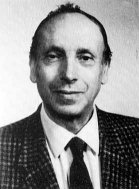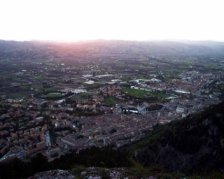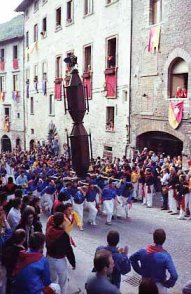|
|
|
|

|
|
| DANTE AMBROGI |
|
|
Biography
 Dante Ambrogi was born in Gubbio in 1924 and lives here in the popular Quarter of St.Martino of which he reflects the sentiment and the costumes.
Dante Ambrogi was born in Gubbio in 1924 and lives here in the popular Quarter of St.Martino of which he reflects the sentiment and the costumes.
With a degree in Medicine and Surgery at the University of Perugia he has practised medicine for many years. He is specialized in Cardiology, in Internal Medicine and in Phthisiology. For 45 years he has been the medical doctor of many eugubinian families, with great humanity and professionality.
Nel 1985 ha ricevuto, come riconoscimento per la sua dedizione alla professione medica, il "Valentino d'oro" (Terni).
He has often participated in literary poetical prizes, managing to win the first prize in some of them, such as the "Premio Ungaretti", won twice, in the "Gran Premio Italia" (Napoli), IN the"Premio Iacopone da Todi", in the "Premio De Amicis" (Torino) in the "Premio Zeus" (Rimini), ecc.
Fa parte dell'Accademia S. Marco (Napoli) e dell'Associazione Amici dell'Umbria (Terni).
He has published very much collections of poems:
- Ritagli di tempo (1960)
- Poesie di trenta anni (1987)
- Poesie tra cronaca e fantasia (1996)
- Ritagli di poesie e racconti (1997)
- La potatura degli alberi (1998)
- Anni percorsi (1999)
- Attimi liberi (2000)
- Spazio d’autunno (2001)
- Speranza (2002)
- Tramonto (2003)
- Ombra e Luce (2004)
- Misticismo che continua... (2005)
- Il Torrente (2007)
- Fibrillazioni moderne (2008)
- Ricordi e riflessioni durante un viaggio (1993)
- Ascensioni (1996)
He always believed that poetry "Was a positive affirmation, not a way of freeing emotion, but a flee from emotion". When talking about his activity as a poet he says: ""it is as if I express myself in human sentiments dictated by the fate of the moment, by the rapid and difficult occasions proposed by human existence, by one's own death which is associated to the regrets and memories and hope of a divine providence.
I still believe that for each of us poetry remains the language which goes beyond the borders of time and history".
His conception of life: "real life is a meeting of a conversation, of glances which are entwined in the silence of love".
Chosen extracts:
Gubbio di sera
Corri San Giorgio
San Martino
Gubbio di sera
Sono tegole forti sbiadite nel tempo
tetti con lucerna aperti al cielo
comignoli dei tetti anneriti dal tempo
strade consunte dai passi.

Ho vissuto tranquillo
tra le tue mura Gubbio
ruvide dal peso della storia
guardo talvolta i cipressi
essi vigilano e difendono il tuo colore
catturando i raggi del sole fino al tramonto.
Il torrente attraversa la tua pianura
la tua città mentre ora le prime foschie della sera
contrastano con le braccia delle gru.
Tutti sono intenti a ricostruire il tuo passato
mentre sotto le volte degli stretti passaggi
senti i fruscii dei piccioni
e vedi l'ultimo concittadino
attraversare il tempo del futuro.
Corri San Giorgio
vivi, corri San Giorgio
non devi mollare
vivi corri non essere automa,

Sii Santo
con la forza per provare emozioni,
con occhi acuti
per vedere luce del Protettore
con la spada per sfiorare l'avvenire.
Non crederti il cavaliere del mondo
ma crediti il centro della corsa.
Scendi dal tuo trono
come un angelo calligrafo
sul quale non siedi
ma stai sospeso
dominatore del folle volo.
sarai sempre una luce
perché saliremo nella tua nave azzurra
per conquistare gl'incanti
dell'altra sponda,
ove sommessi nell'altare dell'amore
pregheremo
perché solo il tuo fluire
è imperativo crescente.
S. Martino
"La nebbia agli irti colli…"
The Festa of San Martino has a special particular flavour. It precedes the winter, especialy in the farm areas where the new wine is tasted, the last product of the year and the supplies for the winter and the coming year are prepared.

In the eugubinian quarter of San Martino the festa has a different significance even if the wine lovers are in majority and the wine barrels to be opened are in abundance, even if most of the canteens have been transformed into garages.
It's a moment of happiness and serenity to forget the daily bustle, and a moment of human passion and sharing.
Domestic happiness is a very difficult aim to reach.
That of the quarter, or at least on paper, should be almost impossible.
In the quarter of San Martino the people are almost always happy because they have never lost the love for the simple things, for the silly joke, for the friendship made solid due to their "briscola" (card game), and also due to a quarter litre of a real good wine.
On the day of the festa of San Martino the friendship ties become even stronger, the merriness more contagious and the jokes even funnier.
The quarter of San Martino turns into a huge village without losing the hearty dignity of a city which is lazily situated on the stony slopes of the mountain.
The consumptionism which has contaminated even the most genuine folklore was not capable of changing the quarter of San Martino.
The only signs of this devastating civilization are the sausages hanging from the point of the cuccagna (a high pole) and the wine to digest the sausages.
On the other hand, this is part of the past which nobody wishes to remove from the present. A period of the past which is relived every day, expecially for the festa of the quarter of San Martino.
The mist rises up to the cliffs of the Mount Ingino and Mount Foce. The smell of the wine revives the merriness among the people and the antique habits of the things which must be done on the day of San Martino, even though they are sometimes repetitive. All this takes us back into time.
In the folds of our memories some people and situations emerge which make us think .
The only things that are missing are the taverns where one could eat a plate of something very simple in order to fill your stomach and drink even more. But now the bars have taken over. Even in San Martino, though, the bars have their original touch, because they seem to be ordinary bars but they are actually taverns in their spirit.
Examples are those taverns of Anesio, Astolfo, Tore, and many others.
Often these people have been considered the black sheep of the town, or even very superficial people.
Instead they were people who knew how to live.
Tore, for example, had a wine debt with Giuina.
Giuina ran after him through the streets of San Martino. And Tore screamed as loud as he could, almost pleading: "Don't worry, Giuina, you'll give it to me some day or other".
This was a demostration of great dignity.
One could write a book of about a thousand pages on the biting expressions of the inhabitants of San Martino.
The triumph of the spirit of the people.
A spirit which, apart from all the rest, still lives.
On the other hand, the spirit never dies.
Even though times have changed and everything that is popular, is looked at with suspect, the traditions of San Martino and its surroundings still remain alive.
All you need to hear are these three names: Baistrocchi, Balenella, Chico. Three artists. The first of restoration, the second of iron, the thirs for painting.
Even Pinocchio used a paint brush. Not to create suggestive ../images, but to cover walls or facings which were not joined.
We could give the merit of all this to the wine, but it would not be fair to say so.
All these people and others who cannot be mention due to the problem of space, have had and still have a common denominator in the semplicity and goodness.
Two sentiments which the consumptionism, materialism, individualism, and permissivity have cancelled from the face of the earth, but not in the quarter of San Martino.
For this reason, bless San Martino which is also the capital of the solidarity.
Not by chance The Workers Society for Mutual Help has its quarters in San Martino.